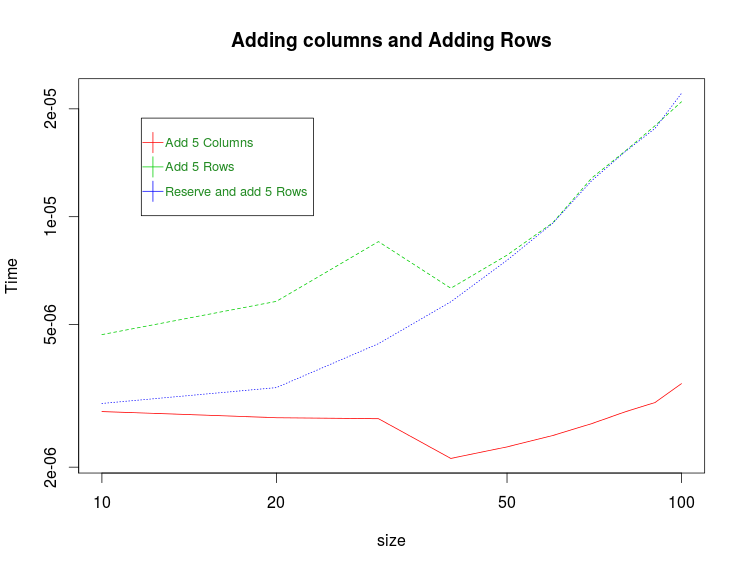This page explain how you can add and or remove columns/rows to an array of the Array2D family and how to merge arrays with the same number of rows without duplicating data.
General features of the Arrays2D
The Array2D is a family of array/vectors/points propose many functionnalities allowing to assd/remove rows/columns. It is also possible to resize them in a conservative way. It is also possible to merge them if the dimension agreed.
Each columns in an Array2D is in a contiguous memory block. Thus, all operations on the columns is fast as it does not involve data copy. This is not the case for the rows. Inserting or appending rows will cause in the best cases a copy of the data. In the worse case, that is, if the number of rows required is greater than the capacities of the rows, it will even cause a re-allocation of a part or all the columns.
Adding rows and columns to Array2D
All the Array2D (That is the arrays deriving from the interface class STK::IArray2D) can add, insert, remove rows or columns to an existing data set.
-
A first example with the columns
Adding columns Output #include "STKpp.h"using namespace STK;{Law::Normal law(1.,2.);A.rand(law);// Adding a column with value 5A.pushFrontCols(Const::VectorX(4)*5);// insert an uninitialized columns at place 2A.insertCols(2, 2);// set x^2 and x^3 with x in columns 1// add an uninitialized columns at the endA.pushBackCols(1);// set x^2 with x in columns 4// do the same with a vector// insert 1 uninitialized element in place 2}This file include all the header files of the STK++ project.The MultidimRegression class allows to regress a multidimensional output variable among a multivariat...Definition STK_MultidimRegression.h:52Index sub-vector region: Specialization when the size is unknown.Definition STK_Range.h:265The namespace STK is the main domain space of the Statistical ToolKit project.A = 0.0615321 -0.617549 -1.11315 2.73537 -1.55495 1.97633 3.92467 2.21783 A = 5 0.0615321 0.00378619 0.000232972 -0.617549 0.381367 5 -1.11315 1.23911 -1.37932 2.73537 7.48223 5 -1.55495 2.41786 -3.75965 1.97633 3.9059 5 3.92467 15.403 60.4518 2.21783 4.91877 B = 1 3 5 6 B = 1 3 3 5 6
-
A Second example with the rows
Adding rows Output #include "STKpp.h"using namespace STK;{Law::Normal law(1.,2.);A.rand(law);// Adding a column with 1A.pushFrontRows(Const::PointX(4));// Insert 2 uninitialize rows at place 2A.insertRows(2, 2);// Set x^2 and x^3 with x in row 1// Add 2 unitialized rowsA.pushBackRows(2);// Set x^2 and x^3 with x in row 4// insert an unitialized element at place 2}A = 5.01666 4.1416 1.91137 0.0289455 -0.330411 0.837067 0.452249 4.28104 A = 1 1 1 1 5.01666 4.1416 1.91137 0.0289455 25.1669 17.1529 3.65332 0.000837844 126.254 71.0404 6.98284 2.42518e-05 -0.330411 0.837067 0.452249 4.28104 0.109172 0.700682 0.204529 18.3273 -0.0360715 0.586518 0.0924981 78.4598 B = 1 3 5 6 B = 1 3 3 5 6
- Note
- It is important to observe that adding/inserting columns to an Array2D does not produce any copy of the data stored, while the same operations involving the rows of the array will produce data movement.
The next graphic give the execution time of the following code
and of the same code by replacing "Cols" by "Rows". The size of the array A was (m,m). It is easily observed that adding rows is time consuming. Observe also that a small amount of space is added at the creation of the object and that the usage of the reserve method can be wise in order to save time.

Removing Rows and Columns
Rows and columns can be also removed from arrays of the Array2D family using remove and popBack methods.
| Removing rows and columns | Output: |
|---|---|
A = -0.368484 -0.816883 2.29464 0.0968061 0.467136 1.46384 1.44368 1.44231 2.00604 -0.447036 3.26891 -1.92511 4.45443 3.14678 1.56722 2.2803 1.86343 1.84961 -2.27432 -0.504987 -0.80423 -1.12455 0.381285 1.07171 -2.01589 5.72782 0.884305 -3.11897 1.19921 3.89621 A = -0.368484 -0.816883 2.29464 0.0968061 -2.27432 -0.504987 -0.80423 -1.12455 -2.01589 5.72782 0.884305 -3.11897 B = 1 2 3 4 5 6 B = 1 2 6 |
Merging two arrays
It is possible to merge an array with an other array or vector without copying the data using the merge method.
| Merge an Array2D with an Array and a Vector | Output |
|---|---|
B.isRef() = 0 A = 1 2 1 2 3 3 4 4 5 6 5 6 7 8 9 B.isRef() = 1 B = 1 2 3 4 5 6 7 8 9 A = 1 2 1 2 3 4 3 4 4 5 6 5 5 6 7 8 9 6 C.isRef() = 1 C = 4 5 6 |